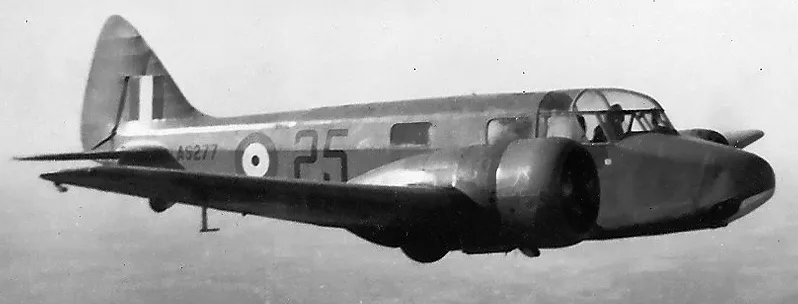Howard, John Alfred (Leading Aircraftman)
Killed in Flying Accident 1943-March-31


Birth Date: 1924
Born:
Parents: Son of Alfred and Mabel Lena Howard, of West Wickham, Kent, England.
Spouse:
Home:
Enlistment:
Enlistment Date: unkown date
Service
RAFVR
Unit
39 SFTS- Service Flying Training School (RAF)
Base
Swift Current, Saskatchewan, Canada
Rank
Leading Aircraftman
Position
Service Numbers
1545132
This incident involved multiple aircraft:
- Oxford Mk. I Serial: X6593
- Oxford Mk. I Serial: AS689
All the above aircraft in the above list are referenced in this report.
Crew or Other Personnel
Oxford X6593
Oxford serial: X6593

Airspeed A.S. 10 Oxford Mk. II, RCAF (Serial No. AS277), 25, in flight over Saskatchewan, 1942.
The Airspeed AS.10 Oxford was a twin-engine monoplane aircraft developed and manufactured by Airspeed. It saw widespread use for training British Commonwealth aircrews in navigation, radio-operating, bombing and gunnery roles throughout the Second World War.
The Oxford was developed by Airspeed during the 1930s in response to a requirement for a capable trainer aircraft that conformed with Specification T.23/36, which had been issued by the British Air Ministry. Its basic design is derived from the company's earlier AS.6 Envoy, a commercial passenger aircraft. Performing its maiden flight on 19 June 1937, it was quickly put into production as part of a rapid expansion of the Royal Air Force (RAF) in anticipation of a large-scale conflict.
As a consequence of the outbreak of war, many thousands of Oxfords were ordered by Britain and its allies, including Australia, Canada, France, New Zealand, Poland, and the United States. Following the end of the conflict, the Oxford continued to achieve export sales for some time, equipping the newly formed air forces of Egypt, India, Israel, and Yugoslavia. It was considered to be a capable trainer aircraft throughout the conflict, as well as being used a general-purpose type. A large number of Oxfords have been preserved on static display. Wikipedia
Aircraft Images
Oxford X6593
Oxford Mk. I X6593
Taken on strength by No. 1 Port Detachment at Halifax, NS. To No. 4 Training Command on 14 October 1941, for use by No. 37 Service Flying Training School at Calgary, Alberta. Winter conversion kit installed at No. 37 SFTS by 30 April 1942. Collided with Oxford AS689 on 31 March 1943, near St. Aldwyn relief field. 2 fatalities in this aircraft. Approval to scrap sent to No. 39 Service Flying Training School at Swift Current, Saskatchewan on 11 May 1943.1941-09-25 Taken on Strength Eastern Air Command 2019-08-20
1943-March-31 Accident: 39 Service Flying Training School Loc: East Of St Aldwyn Rlg Names: Helme | Howard | Simpson
1943-05-11 Struck off Strength Struck off, reduced to spares and produce 2019-08-20
Oxford AS689
Oxford Mk. I AS689
Winter conversion set installed during assembly at No. 9 Repair Depot. To No. 4 Training Command on 11 March 1942, for use by No. 36 Service Flying Training School at Penhold, Alberta. To Aircraft Repair for overhaul, 24 August to 23 December 1942. To storage with No. 4 Training Command when completed, issued from storage on 16 February 1943. With No. 39 Service Flying Training School at Swift Current, Saskatchewan when it crashed 5 miles east of the St. Aldwyn relief field at 11:05 on 31 March 1943, as a result of collision with Oxford X6593 during formation flying training. Pilot Officer J. Helme, RNZAF and Leading Aircraftman J.A. Howard, RAF killed in X6953, Sgt. Simpson, lone occupant of this aircraft uninjured, escaped by parachute. Application to write off dated 24 April 1943. Scraped at No. 39 Service Flying Training School at Swift Current, Saskatchewan.1941-11-03 Taken on Strength No. 9 Repair Depot 2019-08-20
1943-March-31 Accident: 39 Service Flying Training School Loc: 5 Mile East Of St Aldwyn Rlg Names: Helme | Howard | Simpson
1943-05-11 Struck off Strength Struck off, reduced to spares and produce 2019-08-20
Unit Desciption
39 SFTS (39 Service Flying Training School)
Graduates of the EFTS "learn-to-fly" program went on a Service Flying Training School (SFTS) for 16 weeks. For the first 8 weeks the trainee was part of an intermediate training squadron; for the next 6 weeks an advanced training squadron and for the final 2 weeks training was conducted at a Bombing & Gunnery School. The Service schools were military establishments run by the RCAF or the RAF.
There were two different types of Service Flying Training Schools. Trainees in the fighter pilot stream went to an SFTS like No. 14 Aylmer, where they trained in the North American Harvard or North American Yale. Trainees in the bomber, coastal or transport pilot stream went to an SFTS like No. 5 Brantford where they learned multi-engine technique in an Airspeed Oxford, Avro Anson or Cessna Crane.

For More Information on RCAF Station Swift Current see here
RCAF.Info - RCAF Station Swift Current SK
RCAF.Info - Relief Landing Field St Aldwyn SK
RCAF.Info - Relief Landing Field Wymark SK
![]() Saskatchewan Virtual War Memorial - Swift Current Base History
Saskatchewan Virtual War Memorial - Swift Current Base History
![]() Vintage Wings - Ghosts Of Saskatchewan
Vintage Wings - Ghosts Of Saskatchewan
